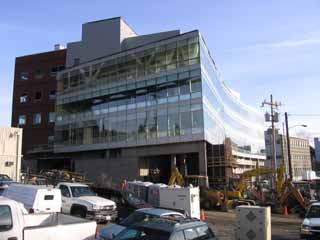
DJC.COM
March 2, 2006
UW's first DBOM building almost done
CollinsWoerman

Collins
|
Construction is about to wrap up on a building at the University of Washington campus that is unlike any other in the state.
The school sought to construct a scientific research building, but there was a catch: it needed to be delivered more quickly and cost effectively than conventional process allows, and the operation costs were to be fixed for 30 years — the average life of a science building before it's either remodeled or demolished.
The result is an innovative building developed under a design, build, operate and maintain — DBOM — contract. The project team included CollinsWoerman, Mortenson and Johnson Controls.
The site for the DBOM project was a challenging parcel located on the western edge of the UW campus. Sandwiched between a waterfront industrial zone and the established neighborhood of Wallingford, the building needed the right mix of design flexibility to meet expectations, fit within the existing campus master plan and complement the neighborhood.
Why DBOM?

Photo courtesy of CollinsWoerman
The $31.5 million Research and Technology Building is being constructed with a design-build process that caps UW's costs and transfers design risks to the builder.
|
The DBOM approach is the primary means of contracting for design, construction, operating and maintenance services related to a building's development. It helps ensure projects are delivered on time and on budget, which is especially critical in an institutional setting where there is little room for changes.
From the beginning, there is a specific amount of funding that is allocated to the winning contractor. All financial issues are addressed early on, leaving no room to request additional funding throughout the process.
The DBOM construction method offers distinct advantages to the building owner for many reasons. Because the bid comes as a complete package at the beginning of the project, there is early, accurate prediction of project cost, transferring the design risk from owner to builder.
The speed of delivery allows the builder to work from less-detailed design documents, start work prior to design completion and commit to subcontractors early in the process, shortening procurement times.
Lastly, the prime contractor selects subcontractors based on relationships and trust, rather than lowest price, which benefits the project management and cuts costs — another plus for the owner.
Lower life-cycle costs
Under the operate-maintain contract, the designer-builder is obligated to operate and maintain the building at a guaranteed price.
This means the design and building component and system decisions are made on a best life-cycle cost basis, rather than first cost.
The designer-builder must live with the consequences of poor quality and can reap the rewards of good quality by beating cost predictions through efficiencies and control of routine maintenance practices. This also results in a better long-term asset for the owner because the long-term building performance is maintained without draining scarce resources.
Tenant churn and building modifications over time are managed by a sole source, improving efficiencies and lowering future tenant buildout costs.
Despite agreement from all parties that the DBOM process would work best for this building, there were still design challenges surrounding the execution. From the beginning, the site's unique shape greatly influenced building design. Early discussions centered on how to fit orthogonal lab modules onto a site that was not conducive to this shape.
The resulting design was based around an orthogonal laboratory planning module structure that is "stretched" along the north side to fit the curvilinear site. Four brick forms, or "fingers," were developed as lab modules with glass that strings the sections together, creating the curve of the building. The space between the lab modules is an enclosed area that provides additional space for research, office work and interaction with other tenants.
3 design principles
Three principles lead the design strategy for the DBOM building:
- — Outside the building: livable, identifiable and memorable
— Inside the building: innovative, flexible and adaptable
— Overall design: clear, simple and authentic
Outside the building, the varied surroundings and different neighbors made the exterior design a challenge, as the site has a neighboring industrial area, established residential neighborhood and is bordered on the north by the Burke-Gilman recreational trail.
The brick on the north facade echoes that of other UW campus buildings. Horizontal ribbed metal siding on the east and west sides evokes the feel of nearby marine and light-industrial structures, and the extensive use of glass on the south side showcases striking views of Lake Union and downtown Seattle.
In recognition of the Burke-Gilman trail, designers chose to preserve and enhance the green space next to it by adding shrubbery and grass between the parking lot and north building entrance.
Inside the building, the university provided a detailed user program, and designers focused on the scientists who would use the building daily. These people and their activities influenced not only the building organization and planning, but also its form and expression.
According to future users, there were three major space needs: flexible space, space for contained activity and space near the lab for highly specialized equipment.
These needs were addressed in the principal design of the building with the "four fingers" of the project. The fingers satisfied the need for contained space, and the area in between the fingers fulfilled the need for space near the lab for specialized equipment and flexible use.
The result increased the number of floors and square feet of usable space and addressed the need for laboratory and flex-use space.
With the coordinated systems installation made possible by the DBOM method, ceilings could be lowered from 15 feet to 13.5 feet, increasing the number of floors from five to six. As a result, the building will deliver 95,000 square feet of usable space, exceeding the original program requirement by approximately 10,000 square feet.
The team also created an underground parking area that can be converted to approximately 8,000 square feet of additional laboratory space should the need arise.
"The DBOM process has allowed the university to deliver a building to tenants that is more efficient and flexible than typical lab buildings, allowing for a wider variety of uses that complement each other all under the same roof," said Eric Smith, UW's associate director of capital projects.
"We're very pleased with the effectiveness of the DBOM delivery model for this building. The Mortenson, CollinsWoerman (and) Johnson Controls team has been a great partner in the process. Working together, I think we have shown that this is a model that could work."
Arlan Collins is a principal with CollinsWoerman, a full service architectural, planning and interior design firm based in Seattle.
Other Stories:
- Biotech developers are going green
- WSU looks to ramp up biotech development
- Public spaces put a friendly face on lab building
- Biotechs differ in needs for space and power
Copyright ©2009 Seattle Daily Journal and DJC.COM.
Comments? Questions? Contact us.